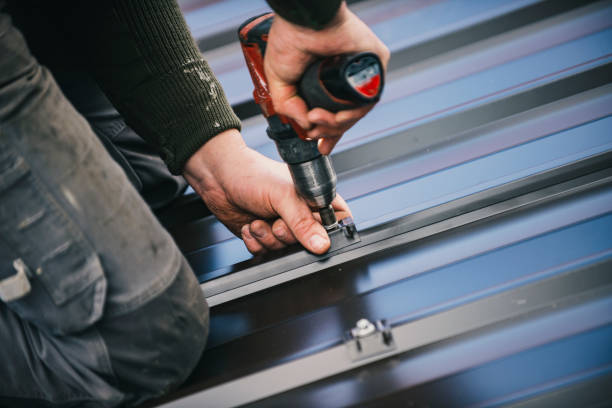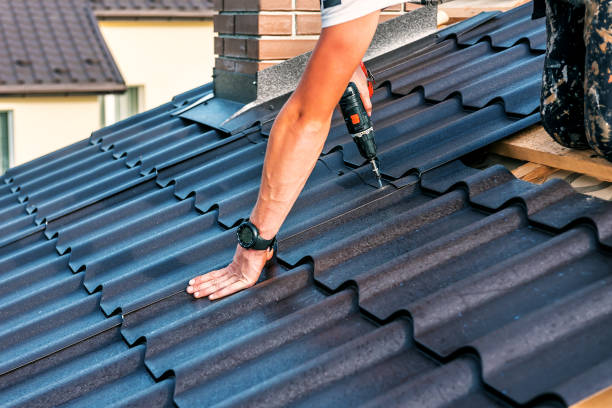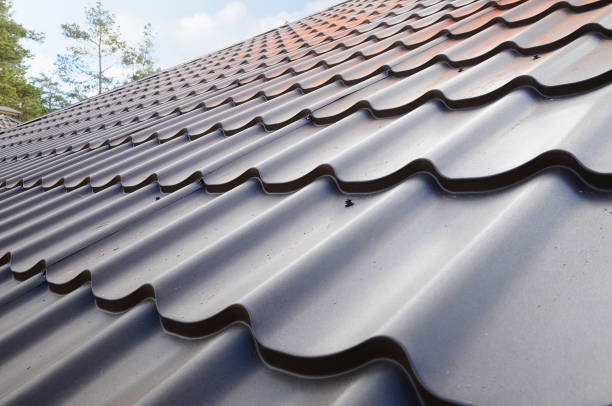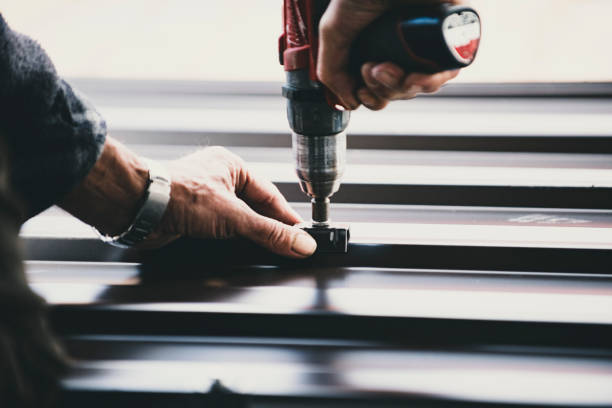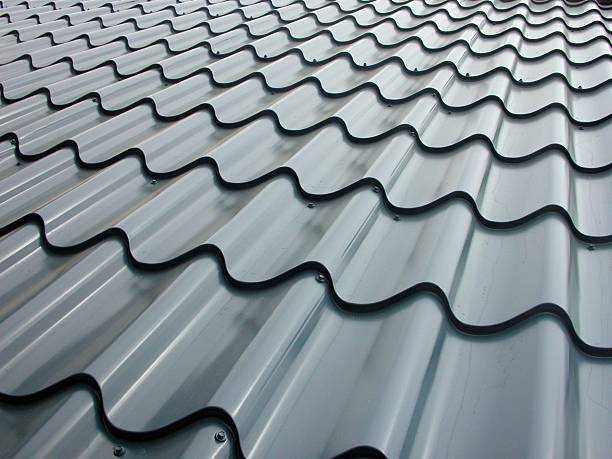Top Seam Designs Offered by a Metal Roofing Company San Diego

Understanding the different types of standing seam systems can help you make an informed decision that aligns with your specific needs.
This system consists of panels with pre-installed clips or fasteners that securely “snap” into place without requiring additional mechanical seaming.
Advantages: – Ease of Installation:Requires less specialized equipment, reducing labor costs.
– Strong Weather Resistance:Keeps wind and rain from penetrating beneath the roof.
– Clean Aesthetic:Offers a sleek and modern appearance with uniform panel lines.
Disadvantages:
– Limited to pitches above 3/12 (optimal for steeper slopes).
– May not provide as tight a seal as mechanically seamed options in extreme weather conditions.
| Feature | Snap-Lock System |
| Ideal Roof Pitch | Above 3/12 |
| Installation Complexity | Moderate |
| Durability | High |
| Common Applications | Residential & Light Commercial |
The mechanical lock system is one of the most robust options available, designed for areas prone to harsh weather conditions like heavy snowfall or high winds.
Advantages: – Exceptional Strength:The double-lock version (180-degree seam) offers unparalleled durability.
– Versatile Pitch Options:Suitable for low-slope roofs as well as steep pitches.
– Long Lifespan:Ideal for long-term applications in challenging climates.
Disadvantages:
– Requires more time and labor due to the mechanical seaming process.
– Higher upfront costs compared to snap-lock systems.
Common Variations:1. Single-Lock (90-degree seam): Easier installation but slightly less strength compared to double-lock. 2. Double-Lock (180-degree seam): Maximum durability but more labor-intensive.
The batten panel system features raised seams that create a bold architectural design element while maintaining excellent waterproofing characteristics. These panels are secured using battens or caps that cover the fasteners beneath.
Advantages: – Striking Appearance:Provides a traditional look often used in historical restoration projects or custom homes.Weatherproof Design:Ensures excellent water resistance comparable to other standing seam systems.Customizable Widths & Heights:Offers flexibility in design choices.
Disadvantages:– Heavier aesthetic may not appeal to all homeowners looking for a sleek design option. – Typically higher material costs compared to snap-lock systems due to additional components like caps or battens.
| Feature | Snap-Lock | Mechanical Lock | Batten Panel |
| Ease of Installation | High | Moderate/Low | Low |
| Cost | Moderate | Higher | Higher |
| Durability | High | Exceptional | High |
| Aesthetic Appeal | Sleek/Modern | Sleek/Sturdy | Traditional/Bold |
This roofing system is characterized by raised seams that run vertically along the roof, creating clean lines and a sleek finish.
1.Durability and Longevity
These roofs are designed to withstand harsh weather conditions such as extreme heat, heavy rain, snow, and high winds.
Key features contributing to their longevity include: – Corrosion-resistant materials like galvanized steel or aluminum. – Protective coatings (e. g. , Kynar 500) that prevent fading or deterioration. – Hidden fasteners that reduce exposure to environmental elements.
| Factor | Impact on Longevity |
| Material Type | Aluminum resists rust; steel offers strength |
| Paint Coating | Protects from UV rays and moisture |
| Seam Design | Reduces risk of water infiltration |
2.Energy Efficiency
This reflective property helps reduce cooling costs during hot seasons while maintaining indoor comfort.
Energy efficiency benefits include: – Reduced cooling energy consumption by up to 25%. – Availability of cool roof coatings that further enhance reflectivity. – Excellent insulation when paired with underlayment systems.
3.Low Maintenance Requirements
– Smooth surfaces prevent debris buildup.
Regular inspections are advisable but typically involve minor upkeep such as clearing debris from gutters or checking for surface scratches.
4.Sustainability
– At the end of their long life span, these roofs can be recycled entirely rather than sent to a landfill.
This sustainability combined with energy-efficient properties makes them a popular choice for environmentally conscious projects.
5.Aesthetic Appeal
– Clean lines created by vertical seams provide a contemporary look.
Customizable Options: | Feature | Choices Available | |———————-|———————————–| | Panel Width | Narrow (12”) or Wide (18”) | | Finishes | Matte, glossy, textured | | Color Range | Neutral tones to bold shades |
Their ability to resist wear and tear while reducing energy bills makes them an excellent long-term investment for any property owner seeking reliability without compromising on style.
Within this category, there are different types of standing seam systems to consider, each offering unique benefits depending on your needs and preferences.
Snap-lock panels feature a simple design where the male and female seams snap together without requiring mechanical seaming during installation. These panels are ideal for roofs with pitches of 3:12 or greater.
- Quick and easy installation
- No special tools required for seaming
- Provides a clean, polished look
- Residential roofing projects
- Moderate climates with minimal snow or ice accumulation
Mechanical lock systems require the use of a mechanical seamer to crimp the panels together at their raised seams. These can be further classified into single-lock (90-degree) or double-lock (180-degree) systems based on how tightly the seams are fastened.
- Superior durability against extreme weather conditions
- Customizable flexibility with single-lock or double-lock options
- Tight seal prevents water infiltration
- Low-sloped roofs below a pitch of 3:12
- Areas prone to heavy snowfall, high winds, or hurricanes
| Feature | Single-Lock | Double-Lock |
| Durability | Moderate | High |
| Weather Resistance | Suitable for mild conditions | Ideal for extreme conditions |
| Installation Time | Faster | Slower |
The nail flange system (sometimes called the fastener flange) is designed primarily for ease of installation in residential applications. A nail slot is built into one side of each panel to attach it directly to the roof deck before locking the adjacent panel over it.
- Simplified installation process without specialized equipment
- Cost-effective compared to other standing seam systems
- Residential homes requiring an affordable metal roofing option
- DIY-friendly projects where professional tools may not be available
Choosing the Right System for Your Roof
While snap-lock panels work well in regions with moderate weather patterns, mechanical lock systems provide increased protection in areas with harsh climates. The nail flange system may be ideal for homeowners seeking affordability and ease of installation without compromising on quality.
By understanding these various options, you can make an informed decision that ensures long-term performance and satisfaction from your metal roofing investment.
What Is the Difference Between Standing Seam and Corrugated Metal Roofs?
When choosing a metal roofing system for your property, one of the most important decisions is selecting between standing seam and corrugated metal roofs. While both options can provide long-lasting durability and aesthetic appeal, they differ significantly in terms of design, performance, cost, and installation. Below is a detailed breakdown of the key differences.
Design Differences
- Feature vertical panels with raised seams (or “ribs”) that run continuously from the ridge to the eave.
- Designed for a sleek, modern appearance with clean lines.
- The seams are mechanically locked or snapped together to create a weathertight seal.
- Consist of sheets with repetitive wave-like patterns or ridges.
- Offer a more traditional or industrial look due to their textured surface.
- Typically fastened using exposed screws, leaving visible hardware on the roof.
Performance and Durability
- Standing seam roofs are highly weather-resistant due to their hidden fasteners and interlocking panels. This design reduces the risk of water infiltration.
- Corrugated roofs may be slightly less resistant as they rely on exposed fasteners, which can loosen over time and allow water leakage if not maintained properly.
- Standing seam systems are better equipped to handle thermal expansion because the concealed clips or floating fasteners give panels room to expand and contract without compromising performance.
- Corrugated roofing does not offer as much flexibility in this area due to fixed fasteners.
- Lifespan:
Both options can last several decades with proper maintenance; however, standing seam roofs typically outlast corrugated systems because their hidden-fastener design minimizes wear-and-tear points.
Cost Comparison
| Roofing System | Typical Material Costs per Square Foot | Installation Costs per Square Foot | Overall Cost Range per Square Foot |
| Standing Seam | $4–$7 | $5–$10 | $9–$17 |
| Corrugated Metal | $1.50–$4 | $2–$5 | $3.50–$9 |
Corrugated roofing is often considered more budget-friendly but may require additional maintenance over time.
Installation Process
- Requires professional installation due to its complexity. Panels need precise alignment and proper seaming techniques.
- Installed with concealed clips or rails that secure the panels without visible fasteners.
- Easier for DIYers or general contractors to install.
- Attached using exposed screws driven directly through pre-drilled holes in the panels.
Aesthetic Appeal
Standing seam roofs are favored in modern architectural designs for their smooth surface and minimalist aesthetic. In contrast, corrugated metal has a rustic charm that suits agricultural buildings, barns, or homes seeking a vintage look.
Summary Table
| Feature | Standing Seam | Corrugated Metal |
| Appearance | Sleek & Modern | Rustic & Industrial |
| Fastener Type | Concealed | Exposed |
| Weather Resistance | High | Moderate |
| Maintenance | Low | Moderate |
| Cost | Higher | Lower |
Carefully evaluating these factors will help determine which roofing system aligns best with your budget, durability needs, and overall aesthetic preferences.
Explaining Oil Canning and How It Relates to Metal Roofs
Oil canning is one of the most commonly misunderstood issues in the world of metal roofing. It refers to the visible, wavy distortions or buckling that can occur in flat or slightly curved sections of metal panels. While oil canning does not impact the structural integrity or functionality of a roof, it may affect its aesthetic appeal, especially for homeowners or businesses seeking a perfectly smooth finish. In this section, we’ll discuss what causes oil canning, factors that influence it, and strategies to minimize its occurrence.
Causes of Oil Canning
Oil canning occurs due to residual stresses in the metal panel. These stresses are introduced during various stages of manufacturing, handling, and installation processes.
- Metal Coil Production: The rolling process used to manufacture metal coils can sometimes leave behind stress within the material. This residual stress may manifest as oil canning when the panels are installed on a roof.
- Panel Installation: Improper handling during installation—such as over-tightening fasteners or uneven substrate preparation—can amplify oil canning effects.
- Thermal Expansion/Contraction: Metal expands and contracts with temperature changes. When panels lack proper room for movement or are constrained by their position on the roof, they may exhibit visible waviness over time.
- Substrate Irregularities: If the substrate (roof deck) underneath isn’t smooth or properly aligned, it puts uneven pressure on the metal panels above it, increasing the likelihood of oil canning.
Factors That Influence Oil Canning
- Material Type: Softer metals like aluminum are more prone to oil canning compared to harder materials like steel due to their flexibility and susceptibility to bending under pressure.
- Panel Design: Wider flat panels with no additional patterning (striations) tend to highlight any distortions more prominently than narrower designs with added features.
- Finish/Coating: Reflective finishes often make oil-canning more noticeable because light highlights even minor surface irregularities.
- Environmental Factors: High temperatures and direct sunlight may exacerbate thermal expansion issues seen in certain installations.
Strategies To Minimize Oil Canning
- Choose Panels With Striations or Stiffening Ribs: These small patterns add rigidity and help reduce visible waviness across broad surfaces.
- Ensure Proper Substrate Preparation: A well-prepared and leveled substrate provides an even base for installing metal panels without introducing stresses.
- Allow For Thermal Movement: Incorporating floating clips or other flexible fastening systems ensures that panels have room for expansion/contraction without distortion.
- Work With Skilled Installers: Choose experienced professionals who understand best practices for handling materials like standing seam roofing systems.
| Method | Impact on Reducing Oil Canning |
| Adding Striations | High |
| Leveling Substrate | Moderate |
| Flexible Fastening | High |
| Professional Installers | High |
Importance Of Managing Expectations
It’s important for property owners considering metal roofing to understand that some degree of waviness is normal for large flat surfaces made from thin gauge metals. Communicating openly with your roofing contractor about expectations regarding aesthetics versus functionality is key when selecting your roof design features.
By taking proactive steps during design/planning phases combined w/quality craftsmanship-you ensure strong visually appealing results while reducing likelihood future distortions long-term!
Understanding Striations, Stiffening Ribs, and Pencil Ribs in San Diego Metal Roofing
Striations, stiffening ribs, and pencil ribs are integral design elements in metal roofing systems. Below is an in-depth exploration of these features to help better understand their importance.
What Are Striations?
Striations are subtle, linear grooves or lines added to the surface of a metal roofing panel.
- Minimizing Oil Canning:Oil canning refers to visible waviness or distortion on flat metal surfaces. Striations help reduce this effect by adding texture that breaks up large flat areas prone to deformation.
- Aesthetic Appeal:Striated panels offer a classic and uniform appearance that suits both residential and commercial buildings.
Striations also make panels less reflective, which reduces glare when sunlight hits the roof.
What Are Stiffening Ribs?
Stiffening ribs are small raised ridges found on the surface of metal roofing panels.
- Increased Panel Strength:By introducing raised ridges, stiffening ribs reinforce the overall rigidity of the panel without adding extra material or weight.
- Wind & Weather Resistance:The additional stiffness helps withstand heavy wind loads or other extreme weather conditions.
- Reduced Thermal Expansion:Stiffening ribs help control how much a panel expands or contracts with temperature changes, ensuring long-term structural integrity.
Stiffening ribs often work best in regions where roofs need added durability due to environmental factors like hurricanes or heavy snow loads.
What Are Pencil Ribs?
Pencil ribs are a type of decorative rib similar to stiffening ribs but with a rounded profile resembling a pencil shape.
- Visual Softness:The rounded design provides a more refined look compared to sharp-edged ribbing patterns.
- Oil Canning Reduction:Like striations and stiffening ribs, pencil ribs also play a role in minimizing oil canning effects by breaking up large flat areas.
- Custom Design Options:Pencil rib patterns vary widely, allowing for more customization based on architectural style preferences.
Comparison Table: Striations vs. Stiffening Ribs vs.
| Feature | Function | Aesthetic Impact | Best For |
| Striations | Reduces oil canning; adds texture | Subtle linear grooves | Homes/buildings seeking clean finishes |
| Stiffening Ribs | Increases strength; resists wind | Functional yet visible ridges | High-stress environments (wind/snow) |
| Pencil Ribs | Combines function with elegance | Rounded ribbed patterns | Custom aesthetics with durability |
How Do You Choose the Right Option?
- For minimalistic designs: Opt for simple striations.
- For decorative needs: Choose pencil ribs.
- If your roof will face high winds or snow loads: Consider stiffening ribs for durability.
- Any of these patterns can help reduce oil canning risks but talk with your contractor about specific project needs.
Below is a step-by-step guide to ensure the installation process is carried out correctly. This guide also highlights essential tools, techniques, and considerations during the process.
Tools and Materials Needed
Before starting the installation, gather the necessary tools and materials to facilitate a seamless process.
- Metal roofing panels (pre-measured and cut)
- Underlayment (e. g.
- Fasteners (e. g.
- Clips or clamps for standing seams
- Sealants and adhesives
- Snips or shears for cutting metal panels
- Measuring tape
- Chalk line for alignment
- Drill or driver with appropriate bits
- Safety gear: gloves, goggles, harnesses
Step-by-Step Installation Process
- Ensure that the roof deck is level, clean, and structurally sound. Any existing roofing material should be removed unless you are installing over an approved substrate.
- Inspect for damages such as rot or cracks in the underlying structure and repair them before proceeding.
- Roll out your chosen underlayment across the roof deck in overlapping rows.
- Secure it using fasteners as per manufacturer instructions to prevent water infiltration.
- Pay attention to valleys, ridges, and edges where additional waterproofing may be required.
- Use a chalk line tool to mark straight guidelines on the roof surface. This helps maintain proper alignment of panels during installation.
- Standing seam systems require clips that allow for thermal expansion while securing panels in place.
- Position clips at intervals specified by the manufacturer (typically every 12–24 inches). Secure them firmly using screws without over-tightening.
- Begin at one edge of the roof (usually from left to right). Place the first panel along your chalk guideline.
- Attach each panel to its corresponding clips while ensuring proper engagement of seam connections between adjacent panels.
- Ensure that seams are tight but not overly compressed to allow for natural expansion/contraction.
- Install ridge caps along peaks to provide weatherproofing at elevated points of your roof.
- Flashings should be installed around chimneys, vents, skylights, or other protrusions following precise measurements to avoid gaps where water can enter.
- Apply recommended sealants at overlaps or vulnerable areas like ridges and valleys for added moisture protection.
- Inspect Installation
Perform a thorough inspection once installation is complete:- Check fastener tightness.
- Ensure all seams are properly secured without gaps.
- Confirm that all accessories (e. g. , ridge caps) are secured according to specifications.
Best Practices During Installation
- Always adhere strictly to manufacturer guidelines specific to your chosen metal roofing system.
- Account for thermal expansion by ensuring there is adequate room within fasteners/clips for movement without stress on panels.
- Prioritize safety by working with appropriate fall protection equipment when installing on steep pitches or high elevations.
Common Mistakes To Avoid
| Mistake | Why It’s Problematic |
| Over-tightening fasteners | Restricts movement of panels due to expansion |
| Improper seam engagement | Leads to leaks or reduced energy efficiency |
| Skipping underlayment | Increases risk of water damage |
| Ignoring uneven substrates | Can cause rippling effects in panel appearance |
- San Diego Metal Roofing: A Complete Guide to Choosing the Right Solution
- Top Seam Designs Offered by a Metal Roofing Company San Diego
- Benefits of Choosing San Diego Metal Roofing and Standing Seam Options
- Benefits and Drawbacks of San Diego Metal Roofing to Consider
- Comprehensive Guide to Choosing the Best Metal Roofing Company San Diego
- Benefits of San Diego Metal Roofing and Why It’s a Popular Choice
- Understanding the Advantages and Disadvantages of San Diego Metal Roofing

